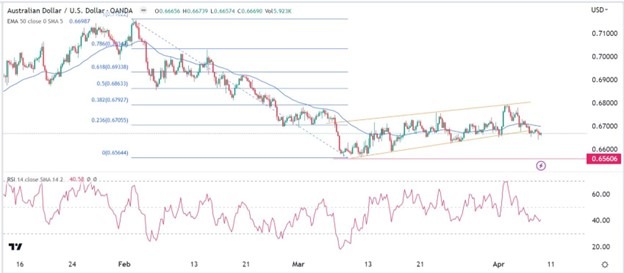Bearish view
- Sell the AUD/USD pair and set a take-profit at 0.6560.
- Add a stop-loss at 0.6720.
- Timeline: 1-2 days.
Bullish view
- Set a buy-stop at 0.6710 and a take-profit at 0.6810.
- Add a stop-loss at 0.6610.
The AUD/USD pair dropped below an important support level last week as traders reflected on the actions by the Reserve Bank of Australia (RBA) and the strong American jobs report. The pair dropped to a low of 0.6644, the lowest point since March 27.
Fed and RBA divergence?
The biggest mover for the AUD/USD pair last week was the interest rate decision by the Reserve Bank of Australia (RBA. In it, the bank decided to leave interest rates unchanged, catching some traders by surprise. It was the first time that the RBA decided to leave rates intact since May last year.
Therefore, there is a possibility that the RBA and the Federal Reserve will move in the opposite direction in the coming months. This is after the US published moderately strong jobs report on Friday. The data showed that the unemployment rate remained at its lowest level in over five decades.
These numbers mean that the Fed can continue hiking interest rates in the coming months if the banking sector remains stable.
The next data to watch that will have an impact on the Federal Reserve is the upcoming inflation data scheduled for Wednesday. Economists expect the data to show that the country’s inflation remained above the Fed’s target of 2.0%. Precisely, expectations are that inflation dropped from 6.0% in February to 5.2% in March.
Core inflation, which excludes the volatile food and energy prices, is expected to have moved from 5.5% to 5.6%.
The other important AUD/USD news will be the upcoming Australia jobs numbers scheduled for Thursday. Economists expect that the unemployment rate rose slightly to 3.6% as the economy created 20k jobs. These numbers’ impact on the pair will be a bit limited since the RBA has already hinted that it will maintain its pause in the coming months.
AUD/USD technical analysis
The AUD/USD pair drifted downwards and is trading at the lowest level since March. It has moved below the lower side of the ascending channel shown in orange. The pair has also moved below the 23.6% Fibonacci Retracement level and the 50-period moving average. Further, the Relative Strength Index (RSI) and the Stochastic Oscillator have moved downwards.
Therefore, the pair will likely continue falling, with the next level to watch being 0.6564, the lowest point in March.
Ready to trade our free Forex signals? Here are the best Forex brokers to choose from.

